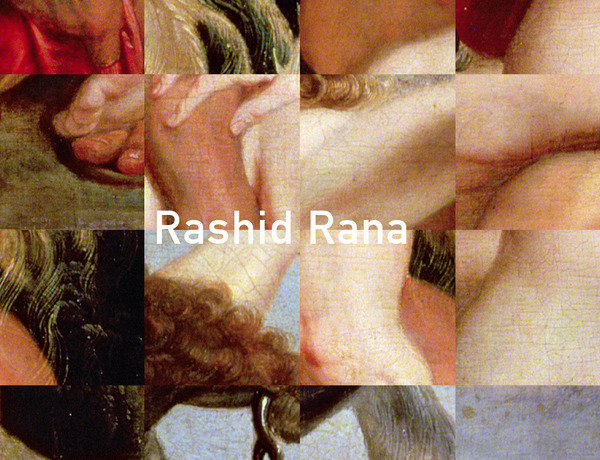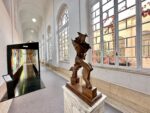Rashid Rana

Manipolando scultura, video e stampa fotografica l’artista trasforma immagini che ritraggono insegne di negozi di Lahore in paesaggi astratti, oppure modifica riproduzioni di grandi classici della pittura in campi di colore.
Comunicato stampa
“My work is often a three-way negotiation between myself, my immediate physical surroundings and what I receive – whether through the Internet, books, history or collective knowledge.” Rashid Rana, ArtReview, 2013
Working with multifaceted, multiplied imagery, Rashid Rana splits the visible universe apart in order to remake it anew. In sculpture, video and photographic prints, Rana transforms snapshots of shop signs in Lahore into abstracted cityscapes or renders reproductions of Old Master paintings as digital fields of colour. Utilising the grid structure, the artist has recently begun to rearrange famous paintings such as The Rape of the Daughters of Leucippus (1618) by Peter Paul Rubens and the Oath of the Horatii (1786) by Jacques Louis-David, scrambling these famous compositions into pixelated and codified puzzles.
Rana’s splicing and stitching technique can be carnal and violent, as in this ongoing series of brutally lacerated and reassembled Baroque and Neo-classical paintings, collectively known as the Transliteration Series. For his first solo exhibition in Italy, Rana has also reflected the legacy of the surrounding city in his source material, choosing paintings by artists hailing from Milan, such as Andrea Solari and Cesare da Sesto. While the originals are held in the Louvre in Paris and the National Gallery in London, Rana symbolically returns the images to the source of their creators, albeit visually distorted and temporally displaced in the process. Rana complicates and realigns such divided notions as figuration and abstraction, manipulation and reality, but also succeeds in knocking the world off its axis and transcending both traditional and technological means of communication.
About the artist
Widely considered to be the leading Pakistani artist of his generation, Rashid Rana first came to prominence in South Asia alongside artists such as Shazia Sikander and Subodh Gupta, before gaining wider, international exposure after the millennium. Rana’s work straddles both Eastern and Western art practices, drawing equally from Islamic forms as from the Renaissance, French Realism or Modernism. Early photomontages – originally made by painstakingly reconfiguring tiny squares of imagery into micro-mosaics by hand, latterly by using computer software – superimposed hardcore pornography on to the silhouette of the burqa (Veil, 2004) and turned hundreds of graphic slaughterhouse snapshots into facsimiles of Persian rugs (Red Carpet, 2007). Rana’s telescoping of politics, civilizations and time also appears in three-dimensions, in works from the series Desperately Seeking Paradise (2007-2011), which splice Lahore’s humble streets and houses with the architectural promise of skyscrapers and the slick lines of Minimalism. Rashid Rana was born in Lahore, Pakistan in 1968. He lives and works between Lahore and Toronto, Canada. He trained as a painter at the National College of Arts in Lahore and at the Massachusetts College of Fine Arts in Boston, before joining the faculty of Beaconhouse National University in Lahore, where he still teaches. Recent solo exhibitions include: Labyrinth of Reflections at Mohatta Palace Museum, Karachi (2013); Cornerhouse, Manchester (2011) and Musée Guimet, Paris (2010). Participation in major group exhibitions includes the Kiev Biennial (2012); Fotomuseum Winterthur, Whitechapel Gallery and Saatchi Gallery, London (2010); the Asia Society, New York (2009), the fifth Asia Pacific Triennale, Queensland Gallery of Art, Brisbane (2006) and the Singapore Biennial (2006).
About Lisson Gallery
Lisson Gallery is one of the most influential and longest-running international contemporary art galleries in the world. Established in 1967 by Nicholas Logsdail, it pioneered the early careers of important Minimal and Conceptual artists, such as Sol LeWitt and Richard Long, as well as those of significant British sculptors from Anish Kapoor and Tony Cragg to a younger generation, led by Ryan Gander and Haroon Mirza. Lisson Gallery represents 45 of the most innovative and exciting artists working today, including six Turner Prize winners and many recipients of the Silver Lion at the Venice Biennale. With two exhibition spaces in London, one in Milan and an office in New York, the gallery supports and develops artists globally, including Marina Abramovič, Allora and Calzadilla, Ai Weiwei, Gerard Byrne, Liu Xiaodong, Tatsuo Miyajima, Rashid Rana, Pedro Reyes and Santiago Sierra. The Lisson Presents programme also extends a legacy of curatorial innovation beyond the gallery spaces, working with institutions and artists to present new initiatives around the world.



